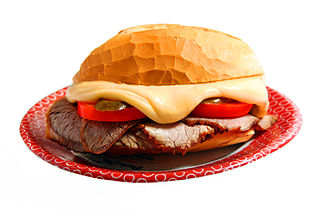
A sandwich is a dish typically consisting of meat, cheese or vegetables used as a filling between slices of bread, or placed atop a slice of bread; or, more generally, any dish in which bread serves as a container or wrapper for another food type, and allows it to be a finger food. The sandwich began as a portable, convenient food in the Western world, though over time it has become prevalent worldwide.

Puebla de Zaragoza, formally Heroica Puebla de Zaragoza, formerly Puebla de los Ángeles during colonial times, or known simply as Puebla, is the seat of Puebla Municipality. It is the capital and largest city of the state of Puebla, and the fourth largest city in Mexico, after Mexico City, Monterrey, and Guadalajara. A viceregal era planned city, it is located in the southern part of Central Mexico on the main route between Mexico City and Mexico's main Atlantic port, Veracruz—about 100 km (62 mi) east southeast of Mexico City and about 220 km (140 mi) west of Veracruz.

The Reuben sandwich is a North American grilled sandwich composed of corned beef, Swiss cheese, sauerkraut, and Russian dressing or Thousand Island dressing, grilled between slices of rye bread. It is associated with kosher-style delicatessens but is not kosher, as it combines meat and cheese.

A beef on weck is a sandwich found primarily in Western New York State, particularly in the city of Buffalo. It is made with roast beef on a kummelweck roll, a roll that is topped with kosher salt and caraway seeds. The meat on the sandwich is traditionally served rare, thin cut, with the top bun getting a dip in jus and spread with horseradish.

A chalupa is one of several specialty dishes of south-central Mexico, including the states of Hidalgo, Puebla, Guerrero, and Oaxaca.

Francesinha is a Portuguese sandwich, originally from Porto, made with layers of toasted bread and assorted hot meats such as roast, steak, wet-cured ham, linguiça, or chipolata over which sliced cheese is melted by the ladling of a near-boiling tomato-and-beer sauce called molho de francesinha. It is typically served with french fries.

A sausage sandwich is a sandwich containing cooked sausage. It may consist of an oblong bread roll such as a baguette or ciabatta roll, and sliced or whole links of sausage, such as hot or sweet Italian sausage, Polish sausage, German sausage, North African merguez, andouille or chorizo. Popular toppings include mustard, brown sauce, ketchup, BBQ sauce, steak sauce, peppers, onions, sauerkraut, chili, and salsa.

The Polish Boy is a sausage sandwich native to Cleveland, Ohio. It consists of a link of kielbasa sausage placed in a bun, and covered with a layer of french fries, a layer of barbecue sauce and a layer of coleslaw. While the sausage is typically grilled, some establishments will quickly deep fry the sausage after grilling and prior to assembling the sandwich.

Pambazo is a Mexican dish or antojito made with pambazo bread dipped and fried in a red guajillo pepper sauce. It is traditionally filled with papas con chorizo or with papas only but there are different varieties.

A pebete is an Argentine and Uruguayan soft oval bun made of wheat flour with a thin brown crust, rather like a fatter hot dog roll. It is often used to make a sandwich, typically filled with cheese, cured meat, tomato and mayonnaise; the sandwich itself is usually called pebete followed by its filling, e.g., pebete de queso.

The jibarito is a sandwich made with flattened, fried green plantains instead of bread, aioli or garlic-flavored mayonnaise, and a filling that typically includes meat, cheese, lettuce and tomato. The original jibarito had a steak filling, and that remains the usual variety, but other ingredients, such as chicken and pork, are common.

Mexican street food, called antojitos, is prepared by street vendors and at small traditional markets in Mexico. Street foods include tacos, tamales, gorditas, quesadillas, empalmes, tostadas, chalupa, elote, tlayudas, cemita, pambazo, empanada, nachos, chilaquiles, fajitas, tortas, even hamburgers and hot dogs, as well as fresh fruits, vegetables, beverages and soups such as menudo, pozole and pancita. Most are available in the morning and the evening, as mid-afternoon is the time for the main formal meal of the day. Mexico has one of the most extensive street food cultures in Latin America, and Forbes named Mexico City as one of the foremost cities in the world in which to eat on the street.

Bauru is a popular Brazilian sandwich. The traditional recipe calls for cheese melted in a bain-marie, slices of roast beef, tomato and pickled cucumber in a pão francês with the crumb removed.

A Gatsby is a South African submarine sandwich consisting of a bread roll filled with chips and a choice of fillings and sauces. It originated in Cape Town and is popular throughout the Western Cape province. The sandwich is typically large and shared by several people.

Lampredotto is a typical Florentine dish, made from the fourth and final stomach of cattle, the abomasum.

A toast sandwich is a sandwich in which the filling between two slices of bread is itself a thin slice of toasted bread, which may be buttered. An 1861 recipe says to add salt and pepper to taste.

An Xuyên Bakery is a bakery in Portland, Oregon.

















